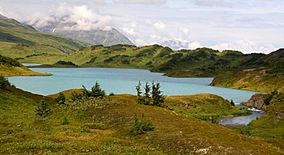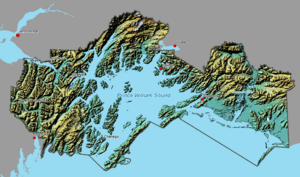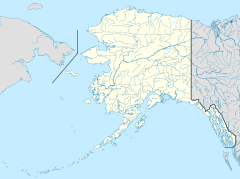Chugach National Forest facts for kids
Quick facts for kids Chugach National Forest |
|
|---|---|

Lost Lake in Chugach National Forest
|
|
| Location | Alaska, United States |
| Nearest city | Anchorage, Alaska |
| Area | 6,908,540 acres (27,957.9 km2) |
| Established | July 23, 1907 |
| Governing body | U.S. Forest Service |
| Website | Chugach National Forest |
The Chugach National Forest is a huge national forest in south-central Alaska. It covers about 6.9 million acres (28,000 square kilometers). This makes it one of the largest national forests in the United States.
The forest includes parts of Prince William Sound, the Kenai Peninsula, and the Copper River Delta. It was created in 1907. The Chugach is full of amazing shorelines, huge glaciers, thick forests, and winding rivers. Much of this land has no roads or trails.
It is home to many different birds, mammals, and sea creatures. For example, it has a very large population of bald eagles. In fact, there are more bald eagles here than in all the other 48 states put together! People visit the forest for fun, like hiking and kayaking. There are also some mining and oil operations.
Contents
History of Chugach Forest
The land that is now the Chugach National Forest was first settled by the Alutiiq people thousands of years ago. Europeans first visited the area in the mid-1700s. Soon after, Russian fur traders came to hunt sea otters.
In 1867, the United States bought Alaska from Russia. This event is known as the Alaska purchase. Gold was discovered in the area in 1888. The Chugach National Forest was officially created in 1907. It was part of a larger forest reserve that had been set aside in 1892.
Exploring Chugach Geography

The Chugach National Forest is located in the mountains around Prince William Sound. It also includes the eastern Kenai Peninsula and the delta of the Copper River. It is the second-largest national forest in the U.S. forest system. It is also the northernmost and westernmost national forest.
About 30 percent of the forest is covered by ice! The Kenai Peninsula part of the forest makes up about 21 percent of the total area. This section includes the southern part of the Iditarod National Historic Trail.
Prince William Sound makes up about 48 percent of the forest. This area has 3,500 miles (5,600 km) of coastline. It also has 22 tidewater glaciers, which are glaciers that flow into the sea. The Copper River Delta covers about 31 percent of the forest. It has the "largest continuous wetlands complex on North America's Pacific coast." Even though the forest is huge, it only has about 90 miles (145 km) of Forest Service roads. However, there are over 500 miles (800 km) of marked trails for exploring.
The main office for the forest is in Anchorage. There are also local ranger offices in Cordova, Girdwood, and Seward.
Islands of Chugach
Several islands are part of the Chugach National Forest.
- Green Island: This island is north of Montague Island in Prince William Sound. There are actually at least three islands named "Green Island" in Alaska!
- Gravina Island: This island is also in the Chugach.
Chugach Climate Overview
The Chugach National Forest has a subarctic climate. This means it has long, cold winters and short, cool summers. A weather station called Cannery Creek is located in the forest. It helps scientists understand the weather patterns.
| Climate data for Cannery Creek, Alaska, 1991–2020 normals, extremes 1979–present | |||||||||||||
|---|---|---|---|---|---|---|---|---|---|---|---|---|---|
| Month | Jan | Feb | Mar | Apr | May | Jun | Jul | Aug | Sep | Oct | Nov | Dec | Year |
| Record high °F (°C) | 46 (8) |
43 (6) |
52 (11) |
64 (18) |
71 (22) |
83 (28) |
83 (28) |
81 (27) |
69 (21) |
58 (14) |
48 (9) |
45 (7) |
83 (28) |
| Mean daily maximum °F (°C) | 28.7 (−1.8) |
31.8 (−0.1) |
36.3 (2.4) |
44.0 (6.7) |
53.0 (11.7) |
60.4 (15.8) |
62.2 (16.8) |
61.0 (16.1) |
53.6 (12.0) |
43.7 (6.5) |
33.7 (0.9) |
30.8 (−0.7) |
44.9 (7.2) |
| Mean daily minimum °F (°C) | 19.9 (−6.7) |
21.4 (−5.9) |
22.1 (−5.5) |
29.0 (−1.7) |
35.4 (1.9) |
44.1 (6.7) |
48.6 (9.2) |
47.4 (8.6) |
41.8 (5.4) |
34.0 (1.1) |
25.9 (−3.4) |
23.0 (−5.0) |
32.7 (0.4) |
| Record low °F (°C) | −18 (−28) |
−11 (−24) |
−4 (−20) |
1 (−17) |
23 (−5) |
29 (−2) |
35 (2) |
31 (−1) |
23 (−5) |
10 (−12) |
−8 (−22) |
−12 (−24) |
−18 (−28) |
| Average precipitation inches (mm) | 10.21 (259) |
9.71 (247) |
6.81 (173) |
6.26 (159) |
7.03 (179) |
5.60 (142) |
7.08 (180) |
13.81 (351) |
17.23 (438) |
14.88 (378) |
11.20 (284) |
12.13 (308) |
121.95 (3,098) |
| Average snowfall inches (cm) | 33.2 (84) |
27.7 (70) |
25.3 (64) |
6.3 (16) |
0.1 (0.25) |
0.0 (0.0) |
0.0 (0.0) |
0.0 (0.0) |
0.0 (0.0) |
2.3 (5.8) |
19.3 (49) |
37.2 (94) |
151.4 (383.05) |
| Average extreme snow depth inches (cm) | 39.9 (101) |
48.3 (123) |
56.3 (143) |
51.2 (130) |
27.1 (69) |
2.0 (5.1) |
0.0 (0.0) |
0.0 (0.0) |
0.0 (0.0) |
2.0 (5.1) |
12.2 (31) |
28.7 (73) |
56.3 (143) |
| Average precipitation days | 17.8 | 16.3 | 15.6 | 15.6 | 17.1 | 16.1 | 18.6 | 19.2 | 21.6 | 21.3 | 17.3 | 20.0 | 216.5 |
| Average snowy days | 11.1 | 10.5 | 9.1 | 2.4 | 0.2 | 0.0 | 0.0 | 0.0 | 0.0 | 1.2 | 7.1 | 12.2 | 53.8 |
| Source 1: NOAA | |||||||||||||
| Source 2: National Weather Service | |||||||||||||
Wildlife and Ecology
The Chugach is a temperate rain forest. This means it gets a lot of rain and has mild temperatures. The forest grows in a narrow strip between the ocean and the icy mountains. The main trees you'll find here are Sitka spruce, western hemlock, and mountain hemlock. This special area is sometimes called the "sub-polar rainforest."
The Kenai Peninsula part of the forest is home to over 200 groups of seabirds. It also has between 3,000 and 5,000 bald eagles. As mentioned, this is almost as many eagles as in the rest of the United States!
The Copper River Delta is one of the most important places for shorebirds in the world. Over 20 million birds visit the Delta every year. In the summer, a quarter of the world's trumpeter swans and dusky Canada geese live here.
Many mammals also live in the forest, including:
- coyotes
- timber wolfes
- moose
- caribou
- martens
- Sitka black-tailed deer
- mountain goats
- black bears
- grizzly bears
The Chugach is the only national forest where you can see Dall sheep. In the waters around the forest, you might spot humpback whales, sea lions, and otters. All five types of Pacific salmon found in North America also live in these waters:
- chinook salmon
- sockeye salmon
- coho salmon
- chum salmon
- pink salmon
Human Activities in the Forest
Very little logging happens in the Chugach National Forest. Less than 2 percent of the forest is used for commercial logging. This is quite unusual for a national forest.
Instead, the forest helps local communities through:
- Tourism: Over 7 million people visit the Chugach National Forest each year. They enjoy activities like kayaking, boating, hiking, skiing, bird watching, and fishing.
- Recreation: Many areas are perfect for outdoor adventures.
- Mining: Some mining operations, including for coal, take place here.
- Commercial fishing: The rich waters support fishing industries.
Even though much of the forest could be protected as "national wilderness," none of it has this special designation yet. In 2003, the government decided that about 3,000 acres (12 square kilometers) of the forest could no longer be used for mining. This was done to protect important areas like the Russian River and upper Russian Lake Recreation Corridor.
Gallery
-
Skiers cross Portage Lake
-
Portage Lake in winter
See also
 In Spanish: Bosque nacional Chugach para niños
In Spanish: Bosque nacional Chugach para niños








